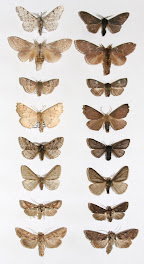There is a further complication. In both 2 and 3 above tarsiers are grouped with anthropoids and adapids are grouped with lemurs and lorises. The problem is adapids share quite a few traits with anthropoids, tarsiers share some traits with anthropoids but not lemurs and lorises. Paleontological data supported a linking of adapids and anthropoids. Comparitive anatomy (hemochorial placenta, presence of a retinal fovea, for example) and biochemical data supported a relationship between tarsiers (and consequently omomyids) and anthropoids. This led to something of a stalemate. If tarsiers (and hence omomyidae) were more closely related to the anthropoids (as the anatomical and biochemical data suggested) then adapids (as the paleontological data suggested) couldn't be. Which was right. A very intersting solution to this problem was presented by Gingerich and Schoeninger in 1977. The suggestion wasn't paid much attention to until 1986, when Rasmussen (in his 1986 paper "Anthropoid Origins: A Possible Solution to the Adapidae-Omomyidae Paradox") revived it. Grant the paleontological evidence that relates the omomyidae to tarsiers and adapidae to anthropoids. Lemurs and lorises would then form a sister group to both the omomyidae-tarsier group and the adapidae-anthropoid group. Consequently, tarsiers would be more closely related to anthropoids than to lemurs and lorises - which satifies the anatomical and biochemical evidence and the omomyid-tarsier and adapid-anthropoid groups could still be kept - satisfying the paleontological evidence.
I bring this up because of recent news. Once you get past the dreck about the "missing link" and small mammals (?) the article has some interesting points. If I read this article correctly the find would actually support Rasmussen. From the article:
The fossilised bones, which are thought to be between 37 and 47million years old, were found in Germany’s Messel Shale Pit, a disused quarry near Frankfurt famous for its fossils.
The team who examined the young female animal say it has some resemblance to a lemur, a mammal with a distinctive tail that is found to this day in the forests of Madagascar.
But Sir David’s documentary will explain that the researchers have, controversially, concluded the fossil ‘is not simply a lemur’ but from a related group of primates which evolved into monkeys, apes and human beings.
This supports the idea that lemurs and lorises are the sister group to two clades composed of omomyidae and tarsiers in one and adapids and anthropoids in the other...
Update 1: Brian has an excellent post on the subject








